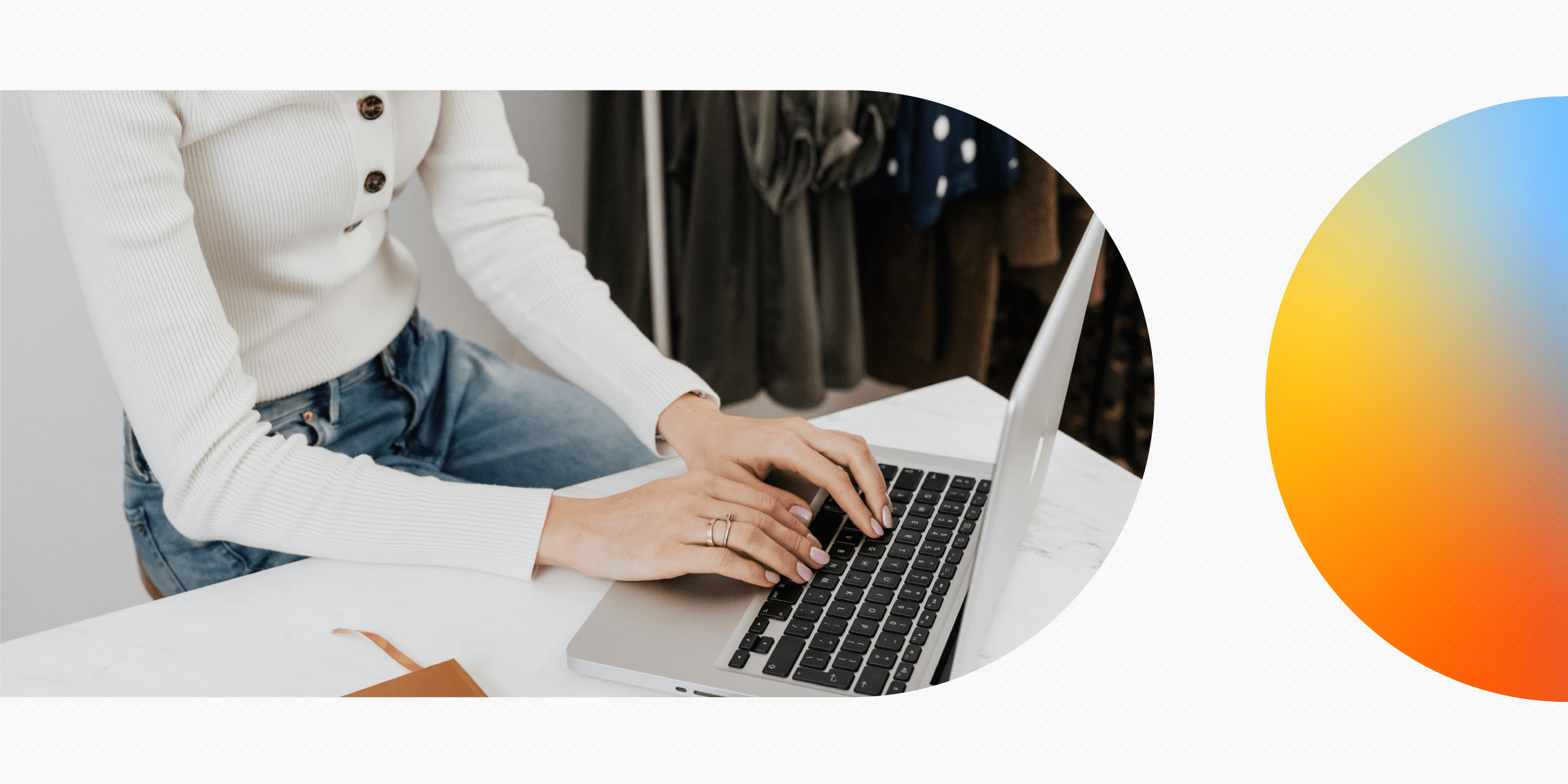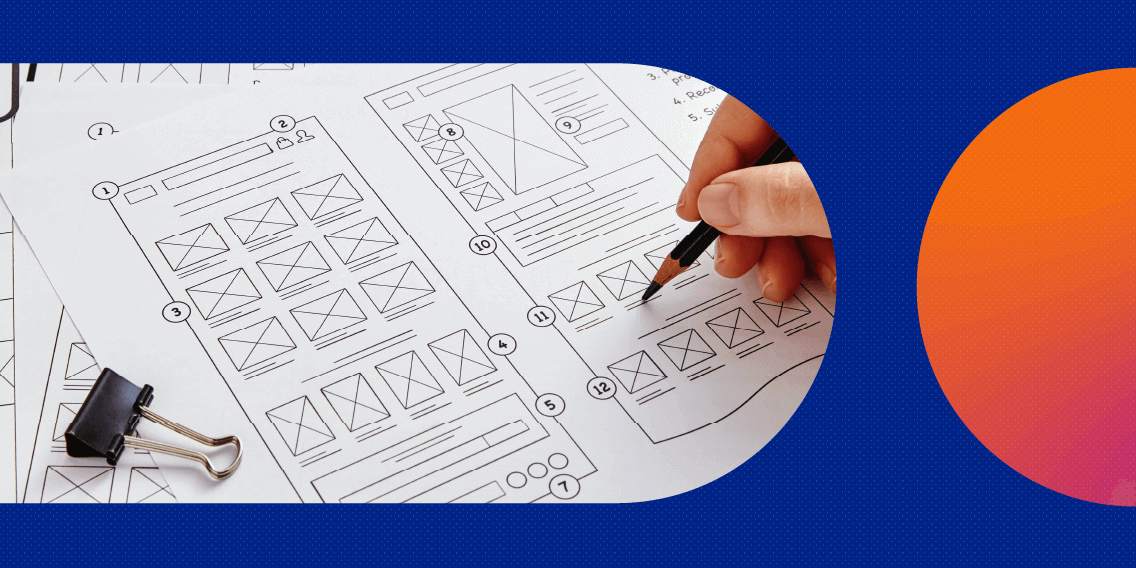If you’re thinking about switching from fashion design to UX, you’ve no doubt got questions.
Like “Is the grass really greener on the other side?” And “Have I got what it takes to become a UX designer?”
Moving from fashion design to UX might feel like a huge leap. But actually, there’s plenty of overlap between the two fields. The skills you’ve developed as a fashion designer—such as creativity, problem-solving, and user empathy—are directly transferable to UX.
In this guide, we’ll cover everything you need to know about making the switch. We’ll explore what the UX industry has to offer in terms of salary, security, and job satisfaction—and we’ll show you how to leverage your background in fashion design for a successful career change.
Why are fashion designers unhappy with their careers?
A career in fashion design is often seen as glamorous, creative, and excitingly fast-paced. And in many ways, it is. But behind the glitzy exterior, working in the industry can be tough.
In June 2023, Vogue Business surveyed over 600 industry professionals about their experience of working in fashion. Discussing the survey’s findings, Bella Webb and Maliha Shoaib write:
“The survey revealed a workforce struggling to reconcile its expectations of working in fashion with the reality: late nights, long hours, limited pay and opportunities, an overemphasis on fickle personal relationships, and a burnout culture spurred by constant travel and overproduction.”
For many, a career in fashion design isn’t all it’s cracked up to be. Here are some of the main challenges that fashion designers face—and the key factors that are driving widespread discontentment within the field.
A high-stress environment without a healthy work-life balance
If you’ve ever watched The Devil Wears Prada, Ugly Betty, or Project Runway, you’ll know that the fashion design industry is notorious for its high-pressure environment, driven by tight deadlines, ever-changing demands, and impeccably high standards.
While movies and TV shows may not be entirely accurate in their portrayal, it’s not uncommon for fashion designers to regularly work long hours in a high-stress environment.
At the same time, fashion design jobs typically require on-site presence. As such, there’s limited flexibility within the field—making it difficult to maintain a healthy work-life balance.
Referring back to Vogue Business’ survey of over 600 fashion industry professionals, 48% of respondents say they work more than their contracted hours, while over 50% of respondents must travel for work at least once every few months.
Overtime, frequent travel, stress, and burnout are seemingly par for the course—leading many fashion designers to rethink their careers.
Low pay and economic instability
Despite the high pressures of the job, fashion designer salaries rarely reflect the amount of hard work and creativity required.
Entry-level roles in particular tend to be low-paid, but even established fashion designers may struggle with financial instability—especially if they’re freelancing or working for smaller brands.
Job site Indeed reports an average salary of around €30,000 per year for fashion designers in Ireland (compared to the national average salary of €45,000 – €50,000 across all occupations).
And, while this average may not be reflective of all fashion designer salaries, it does highlight the point that fashion design isn’t necessarily the most lucrative or financially stable career path.
Ethical, moral, and environmental concerns
The fashion industry faces increasing scrutiny for its environmental impact and (un)ethical practices. Issues such as pollution, waste, exploitation of labour, and unsustainable production processes are a major concern for many fashion designers.
Diversity, equity, and inclusion is another huge issue. In 2023, celebrity stylist Law Roach announced his retirement, citing the fashion industry’s overt nepotism, and “politics and false narratives” as driving factors.
The fashion industry has many deep-seated, systemic issues that are increasingly coming to light—causing widespread disillusionment and dissatisfaction among fashion designers and other industry professionals.
Concerns about purpose and problem-solving
While creatively fulfilling for many, fashion design can leave you feeling like your work lacks meaningful impact.
The industry’s focus on aesthetics, trends, and consumerism can feel shallow—especially for those who want to use their skills to solve real-world problems or drive positive change.
That’s not to undermine the importance of fashion design in empowering creative expression, shaping personal and cultural identities, and challenging societal norms.
But, given the challenges we’ve explored so far, many designers feel like they simply don’t have the opportunity to achieve this in their work.
Why consider a career in UX?
For fashion designers looking to switch careers and apply their skills elsewhere, UX design stands out as a highly appealing alternative.
How so? Here’s what you can expect from a career in UX.
Growing demand and a positive future outlook
In their Future of Jobs report, the World Economic Forum cites UX and design skills among the top 10 skills to be prioritised by businesses globally.
UX hiring managers are seeing this reflected within their organisations. In a survey of over 500 UX professionals, 68% of those responsible for hiring said they expect demand for UX skills to increase at their company in the next 1-2 years.
Meanwhile, the U.S. Bureau of Labor Statistics projects that overall employment of web developers and digital designers (that includes UX designers) will grow 8% from 2023 to 2033—faster than the average for all occupations.
UX/UI designer is ranked 6th on Indeed’s list of the 25 most in-demand jobs for 2024, while product designer jobs (which incorporate both UX and UI) are expected to increase at a rate of 3% between 2018 and 2030.
Overall, there continues to be a steady demand for UX skills. With ongoing continued growth in the tech industry, and rapid digital transformation in sectors such as finance, medical tech, and government, the future outlook for user experience (UX) designers is generally very positive.
Read more: Is the UX job market oversaturated? An in-depth analysis and outlook for 2024.
A competitive salary
While low pay can be a sticking point for many fashion designers, UX designers tend to be well-paid—often earning above the national average.
In Ireland, the average salary for a mid-level UX designer is around €55,000 (per Indeed)—compared to the national average salary of €45,000 – €50,000 across all occupations. Senior UX designers earn an average salary of around €73,000.
In the United States, the average salary for a mid-level UX designer is around $95,000, while senior UX designers can earn upwards of $120,000. This is significantly higher than the national average salary across all occupations, which sits in the $58,000 – $65,000 range.
A career in UX offers great earning potential, even for entry-level professionals. For more salary data, refer to our full UX designer salary guide.
Impactful work and high job satisfaction
UX design is all about addressing real-world problems and creating solutions that improve people’s lives.
On a day-to-day basis, you might “only” be designing a new product or feature—but, in the grand scheme of things, you’re helping to make technology more enjoyable, inclusive, and accessible. This gives UX designers a great sense of accomplishment in their work.
No wonder UX designers report an above-average level of career satisfaction. In a survey of over 500 UX professionals conducted by the UX Design Institute, 92% said they are satisfied with their careers.
Diverse and varied career opportunities
A career in UX offers a broad and diverse range of pathways and specialisations across a variety of sectors.
From user research to interaction design, information architecture through to UX writing/content design and UX strategy; there are countless specialist roles within the field that speak to different skills and interests.
At the same time, UX professionals can work in a variety of sectors, industries, and company types. From tech, healthcare, finance, and government, to large corporations, early-stage startups, and nonprofits—UX design skills are in demand across the board.
With a career in UX, you won’t be boxed into a particular niche; you can enjoy great opportunities for mobility, variety, and continuous learning.
Read more: 11 of the most popular UX roles and job titles explained.
Flexibility and a good work-life balance
Unlike fashion design, which often requires in-person presence, a career in UX can be much more flexible—especially with the rise of remote and hybrid roles.
Even the collaborative and people-facing aspects of the job—like user research, stakeholder meetings, and usability testing sessions—can be conducted remotely. Thanks to virtual tools like Figma and Miro, UX designers rarely need to be in the same room as their colleagues to achieve great results.
Whether you want to work and travel, take a job in a different city, or simply enjoy a better work-life balance; UX design is one of the most flexible careers around.
Read more: Want a career in UX? Here’s why it’s a smart move.
From fashion design to UX: 8 transferable skills that will enable your career-change
If you want to switch from fashion design to UX, transferable skills are your superpower. You might think you’re starting completely from scratch—but actually, there’s plenty of overlap between fashion design and UX.
And, if you do decide to make the move, you certainly won’t be alone. Of 537 UX professionals surveyed by the UX Design Institute, 76% transitioned to UX from another career path.
So what have fashion design and UX got in common? Here are eight transferable skills that will set you in good stead for a career in UX:
- Problem-solving: Both fashion and UX design involve coming up with innovative solutions to complex problems—whether it’s designing functional clothing with specific materials, or creating intuitive digital products within certain technical constraints. The ability to think critically and problem-solve is a major asset in UX.
- Creativity: Just as fashion design often merges style with practicality, UX design is all about striking a balance between visual appeal and usability. Both fields require creativity and an ability to think outside the box.
- Empathy and user-centred design: Both fashion designers and UX designers must understand the needs, preferences, and expectations of their target audience. In UX, empathy drives the creation of user-friendly products that meet your customers’ needs—much like tailoring clothes to suit a specific client or customer base.
- Research: In fashion design, you conduct consumer research, trend analysis, and competitor research to guide design decisions. The same goes for UX, where user research and analysis are essential for informing the direction of the product.
- Attention to detail: Precision is crucial in both fashion design and UX. Whether it’s designing or tailoring an item of clothing down to the last stitch, or aligning elements on a screen—a keen eye for detail is a must.
- Prototyping, testing, and iteration: Both fashion design and UX follow iterative processes that involve designing, prototyping, testing, and refining until the final product is ready. Although the exact tools and methods may differ, the approach is largely the same across both fields.
- Project management: Managing timelines, resources, and team coordination is vital in both fashion design and UX. Whether launching a fashion line or creating a digital product, strong project management skills ensure that projects are completed successfully and on time.
- Communication and collaboration: Both fashion designers and UX designers work closely with clients, stakeholders, and end-users/consumers. Effective communication and collaboration are crucial in both fields—helping you to foster alignment among stakeholders, build a rapport with your team, and effectively communicate your ideas.
As you can see, a career in fashion design lays a solid foundation for a career in UX. So what can you do to set your career-change in motion? Let’s take a look.
How to go from a fashion designer to a UX designer
1. Do your research
Before you commit to any kind of career change, make sure you have a thorough and clear understanding of what your chosen career path entails.
Read blog articles, watch YouTube videos, and take free courses to get a well-rounded view of what UX design is and what a UX designer does—and to learn some of the fundamental principles that underpin the field.
Use these resources to kick-start your research:
- What is UX design?
- A step-by-step guide to the UX design process
- What does a day in the life of a UX designer look like?
- 7 fundamental UX design principles all designers should know
- 8 of the best free UX design courses
2. Take a professional course
If you’re serious about transitioning from fashion to UX, you’ll need practical training in how to apply the UX design process.
A professional UX design course gives you a structured learning pathway to follow—and, depending on who you study with, regular feedback and support from expert mentors and tutors.
With the Professional Diploma in UX Design offered by the UX Design Institute, you can learn flexibly at your own pace (important if you’re currently working and need to fit your studies around your job).
You’ll complete practical projects, get feedback from expert mentors, and be part of a thriving student community.
Once you’ve completed the course (which you can do in 6 months if you dedicate around 5 hours per week), you’ll graduate with a professional certification in UX. This enables you to verify your skills and stand out in the job market.
Given that 77% of hiring managers look for a UX-specific qualification when hiring entry-level candidates, this certification may prove crucial for your career change.
And, because the UX Design Institute diploma is university credit-rated by Glasgow Caledonian University, it will be instantly recognised by professionals in the industry.
Read more: 6 reasons to choose a university credit-rated UX certification.
3. Build your UX design portfolio
If you’re working in fashion design, you know all about the importance of a professional portfolio. And UX is no different—you need a strong portfolio to demonstrate your skills and show employers what you’re capable of.
A UX design portfolio usually takes the form of a personal website. It contains an “About” page or section, contact details and links to social profiles, and, most importantly, a collection of UX case studies.
Case studies focus on real UX projects you’ve worked on, outlining the problem you set out to solve, the process you followed, the final product or designs, and the value this created for both the end-user and the business.
As a newcomer to the field, finding projects for your portfolio can be challenging. That’s why it’s so important to choose a UX design course that includes hands-on project work.
You can learn more about how to create a UX design portfolio from scratch in this guide.
4. Reimagine your personal brand
An important yet oft-overlooked aspect of career-change is how you market yourself to employers. As part of your transition into UX design, you’ll need to reimagine your personal brand.
Your personal brand is essentially how you present and portray yourself to your professional network. It’s shaped by your resumé, your online presence (on LinkedIn especially), and your portfolio.
As you complete your UX studies and prepare to apply for UX jobs, start positioning yourself as a UX designer. Update or rewrite your CV so that it emphasises your newfound UX skills, and update your LinkedIn heading and bio to focus on UX.
The goal is to craft a narrative that highlights your passion for UX, your burgeoning skills and new qualification(s), and the value you can bring to the field.
Ultimately, whenever an employer or potential industry connection comes across your profile, they should immediately understand that you’re an aspiring UX designer looking for UX design opportunities.
5. Leverage and emphasise your transferable skills
You might be new to UX, but you’re not new to the workplace. As we explored earlier, your career in fashion design has equipped you with many transferable skills that are essential for UX.
As you build your personal brand, update your resumé, and speak to employers, draw clear connections between your career in fashion design and UX.
You might talk about how your ability to understand client needs and consumer trends in fashion will help you to be an empathy-driven, user-centric UX designer, for example.
In interviews especially, use the STAR framework to provide specific examples of on-the-job scenarios where you demonstrated UX-relevant transferable skills—focusing on things like creativity and problem-solving, research, empathy, communication, and collaboration.
By framing your existing skills and experience in the context of UX, you can put forward a compelling case as to why you’re an excellent fit for a UX design role.
Read more: Switching to a career in UX? Here’s how to reframe your previous experience and use it to your advantage.
6. Network within the UX community
Your transition into UX will be a whole lot easier if you have a strong network around you. Not only is networking an invaluable source of support and industry insights—it can also help you land your first UX role.
Start by attending UX meetups, workshops, and conferences (either locally or online) to immerse yourself in the community. At the same time, join relevant online forums and social media groups, and be active on LinkedIn.
It might feel daunting at first, but stick with it. Networking not only helps you gain knowledge and confidence; it also increases your visibility in the UX community. This should make it easier to discover job opportunities, receive referrals and recommendations, and generally position yourself as a passionate UX designer.
Read more: The ultimate guide to UX networking (plus 5 tips for success).
7. Look for relevant roles
When searching for your first UX design role, you might be inclined to focus on the tech sector. And, while tech is a natural fit for UX designers, there are many other industries offering exciting opportunities.
In particular, think about industries and sectors where your background in fashion design will be especially valuable.
The retail industry is a great example. More and more retail brands are hiring for UX skills as they invest in creating seamless online and in-store experiences. With your background in fashion and your UX know-how, this is an area where you can really stand out.
Beyond that, explore sectors and brands that speak to your personal interests and passions. Nonprofits and government agencies are also investing heavily in UX, as are the medical technology and finance sectors.
Read more: How to find UX jobs beyond the tech industry (and why it’s a smart strategy).
Learn more about forging a career in UX
We hope you’ve enjoyed learning about the UX industry—and feel empowered to start your career-change. As we’ve highlighted, there’s plenty of overlap between fashion design and UX design; you’ve already got many essential UX skills in your repertoire.
If you’d like to learn more about the Professional Diploma in UX Design, you can request further details via the official course page, or book a call with an education advisor. They can answer any questions you may have, and help you figure out your next steps.
Want more career tips and UX industry insights? Continue with these guides:
- The top UX design trends shaping the industry right now (and what they mean for UX designers)
- Will AI replace UX designers?
- Want to start a career in UX? Why bootcamps and free courses are not the answer





